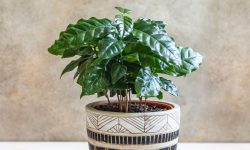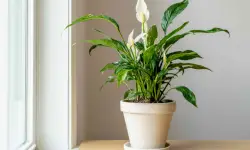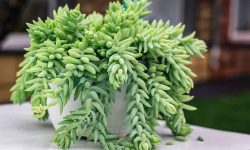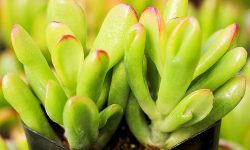Is your arrowhead plant drooping? This phenomenon can be alarming especially if your arrowhead plant looked great yesterday. But do not be alarmed since this circumstance is normal and can easily be fixed.
Dry potting soil is the leading cause of leaf drooping among many indoor plants. Your arrowhead plant thrives in moist soil that never gets soggy. Schedule a strict watering routine to keep the potting soil consistently moist.
If you notice the leaves of your arrowhead plant keep drooping despite fixing incredibly dry soil, it could be due to another problem. We wrote this article to help you identify the exact cause and tips for fixing it.
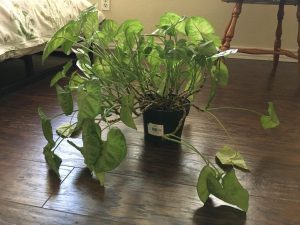
10 Causes of Arrowhead Plant Drooping
Overwatering Problem
Overwatering is a common factor that can cause arrowhead plants to droop. When the plant receives more water than it needs, the roots become saturated, leading to poor oxygen circulation. As a result, the roots may begin to rot, causing stress to the plant and resulting in drooping leaves.
To revive a drooping arrowhead plant due to overwatering, it is crucial to address the underlying issue. First, remove the plant from its pot and examine the roots. If they appear brown, mushy or have a foul odor, it indicates root rot. Trim away the affected roots and repot the plant in fresh, well-draining soil.
Allow the soil to dry out before watering the arrowhead plant again. It is essential to establish a watering schedule that allows the soil to dry slightly between waterings. Ensure that the pot has drainage holes to prevent water from pooling at the bottom.
Underwatering Issue
Underwatering can also cause arrowhead plants to droop. When the plant does not receive sufficient water, it becomes dehydrated, leading to wilted and drooping leaves. The lack of water affects the plant’s ability to perform essential functions like photosynthesis and nutrient uptake.
To revive a drooping arrowhead plant due to underwatering, begin by thoroughly watering the plant. Ensure that water reaches the root zone, allowing it to absorb moisture. Let any excess water drain out of the pot to avoid waterlogging.
Monitor the plant closely and adjust the watering frequency to maintain adequate soil moisture levels. Consider placing the arrowhead plant in a location with appropriate light and temperature conditions to reduce stress.
Increase the humidity around the plant by misting its leaves or placing a tray filled with water and pebbles nearby. These measures will help the arrowhead plant recover from dehydration and regain its turgidity.
Incorrect Lighting
Insufficient or incorrect lighting conditions can cause arrowhead plants to droop. These plants thrive in bright, indirect light. When exposed to intense sunlight or low light levels, arrowhead plants may experience stress, resulting in drooping foliage.
To address this issue, relocate the arrowhead plant to an area that provides the appropriate lighting conditions. Place it near a north or east-facing window where it can receive bright, indirect light throughout the day.
If the plant has been exposed to direct sunlight, move it to a spot with filtered light to prevent leaf scorching. If the arrowhead plant has been in a low-light environment, consider supplementing with artificial lighting.
Use full-spectrum grow lights or fluorescent lights to provide the necessary intensity and duration of light. Maintain a consistent light schedule of 12-14 hours per day to promote healthy growth and prevent drooping.
Lack of Humidity
Arrowhead plants naturally thrive in humid environments, so low humidity levels can cause their leaves to droop. In dry conditions, the plant loses moisture rapidly through its leaves, leading to dehydration and drooping foliage.
To revive a drooping arrowhead plant due to low humidity, increase the moisture in the surrounding air. One effective method is to use a humidifier to raise the humidity levels in the room.
You can also place the plant on a tray filled with water and pebbles. As the water evaporates, it increases the humidity around the plant. Regularly misting the leaves with water can also provide temporary relief and raise humidity.
Ensure proper watering practices by maintaining a consistent watering schedule and avoiding extremes of dryness or excessive moisture. By addressing the humidity levels and providing adequate hydration, the arrowhead plant should regain its vitality and perk up.
Overfertilization
Overfertilization can cause arrowhead plants to droop and exhibit signs of nutrient burn. When excessive fertilizer is applied, salts build up in the soil, disrupting the plant’s ability to absorb water and nutrients properly.
This imbalance can lead to root damage and nutrient toxicity, resulting in drooping and yellowing leaves. To revive a drooping arrowhead plant due to overfertilization, flush the soil with water to leach out the excess salts.
Gradually increase the frequency of watering to help remove the accumulated fertilizer from the soil. Avoid applying any additional fertilizer until the plant recovers. It’s essential to follow the proper fertilization guidelines for arrowhead plants.
Use a balanced, water-soluble fertilizer specifically formulated for houseplants. Dilute the fertilizer according to the instructions provided and apply it during the plant’s active growing season.
Extreme Temperature
Extreme temperature fluctuations can stress arrowhead plants, leading to drooping leaves. These plants prefer temperatures between 60-75°F (15-24°C). Exposure to temperatures below 50°F (10°C) or above 90°F (32°C) can cause leaf wilting and damage.
To revive a drooping arrowhead plant due to extreme temperatures, move the plant to a more suitable location. Avoid placing it near drafts, heating vents, or air conditioning units that can create temperature extremes.
Maintain a consistent temperature within the plant’s preferred range to promote healthy growth and prevent drooping. During colder months, protect the arrowhead plant from cold drafts and provide supplemental heat if necessary.
In hot weather, shield the plant from direct sunlight or move it to a cooler area with indirect light. Adequate insulation and ventilation in the room can help maintain stable temperatures for the plant’s well-being.
Root-Bound Arrowhead
When an arrowhead plant becomes root-bound, with its roots densely packed in a small container, it can result in drooping and stunted growth. The lack of space restricts root development, affecting nutrient and water uptake, leading to stress and drooping leaves.
To revive a drooping arrowhead plant due to being root-bound, gently remove the plant from its pot and examine the root system. If the roots are tightly circling the root ball, it’s time to repot the plant into a larger container.
Choose a pot that provides enough room for the roots to grow and has drainage holes. Carefully loosen the root ball and trim any damaged or excessively long roots. Place the plant in the new pot, adding fresh, well-draining potting soil around the roots.
Firmly press the soil to eliminate air pockets. Water the plant thoroughly and place it in an appropriate location with suitable lighting and temperature conditions. Monitor the arrowhead plant closely after repotting, ensuring it receives adequate water and adjusts to the new environment. With proper care, the plant should recover and regain its vitality.
Syngonium Drooping After Repotting
Arrowhead plants, also known as Syngonium, can experience drooping leaves after repotting due to transplant shock. Repotting can disturb the plant’s root system, causing temporary stress and drooping foliage.
To revive a drooping arrowhead plant after repotting, ensure that the plant receives proper care and attention. Keep the plant in a well-lit area with indirect sunlight and maintain a consistent temperature within the preferred range.
Water the plant appropriately, allowing the soil to slightly dry out between waterings. Avoid overwatering or underwatering the newly repotted arrowhead plant. Strive for balanced moisture levels, ensuring that the soil is adequately hydrated but not waterlogged.
Mist the leaves occasionally to increase humidity and provide a favorable environment for the plant’s recovery. Be patient and allow the arrowhead plant time to adjust to its new pot and root system.
With proper care, the plant should recover from the transplant shock, and the drooping leaves should gradually regain their turgidity.
Pest Infestation
Pest infestations, such as spider mites, aphids, or mealybugs, can cause arrowhead plants to droop. These pests feed on the plant’s sap, weakening it and causing stress that leads to drooping leaves. They may also leave behind a sticky residue or cause discoloration on the leaves.
To revive a drooping arrowhead plant due to pest infestation, start by identifying and removing the pests. Inspect the plant thoroughly, paying close attention to the undersides of leaves and leaf joints. Use a gentle spray of water or wipe the leaves with a damp cloth to remove pests manually.
For severe infestations, consider using insecticidal soap or horticultural oils specifically formulated for houseplants. Follow the instructions carefully and apply the treatment accordingly. Repeat the process as necessary to ensure complete eradication of the pests.
After dealing with the infestation, provide optimal care for the arrowhead plant to aid in its recovery. Maintain a clean and hygienic environment, ensure proper watering and lighting conditions, and monitor the plant regularly for any signs of recurring pests.
Acclimation
When arrowhead plants are moved to a new environment or exposed to sudden changes in light or temperature, they can experience acclimation issues, resulting in drooping leaves. The plant needs time to adjust to the new conditions and may exhibit temporary drooping until it adapts.
To help a drooping arrowhead plant acclimate to a new environment, provide stable conditions that closely match its previous growing conditions. Gradually introduce changes in light intensity, temperature, or humidity over a period of weeks to allow the plant to adjust gradually.
Ensure that the arrowhead plant receives proper care during the acclimation period. Monitor watering, lighting, and humidity levels to maintain optimal conditions for the plant’s recovery.
Avoid exposing the plant to extreme conditions or sudden changes that could cause additional stress. With patience and consistent care, the arrowhead plant should gradually acclimate and regain its vigor, resulting in improved leaf health and reduced drooping.
Final Thoughts from Experts
If your indoor arrowhead plant is drooping, examine the moisture content in the pot. I recommend inserting your finger into 2-3 inches of the topsoil or using the moisture meter to determine the soil moisture level.
Underwatering will make your arrowhead plant struggle and can easily be fixed. But overwatering might end up killing your houseplant if not fixed on time. Fixing an overwatered arrowhead plant isn’t a walk in the park.
Be sure to examine your houseplant thoroughly since watering couldn’t be the only issue. Feel free to share your experience with us and the steps you used to fix an arrowhead plant drooping in the comment section. Cheers!
People Who Read This Also Read:



